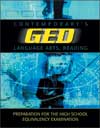|
 |  Contemporary's GED Language Arts, Reading John M. Reier
Drama
Chapter OutlineStudy the chapter outline below. Use the page numbers below each topic to refer to the corresponding section in Contemporary's GED Language Arts, Reading. When you are finished, go to the Flashcards or choose a different activity or chapter from the menu on the left.
Drama
(See page 249)
Drama consists of written works designed to be acted out on a stage in which the writing consists almost entirely of dialogue between characters. |
 |  |  | Recognizing the Parts of a Script
(See pages 255–259)
- Acts are the major sections of long plays.
- Scenes are specific episodes from a story set in one place and occurring during a fixed time period.
- The cast list introduces the characters.
- Stage directions establish the setting and suggest a character’s tone of voice, feelings, facial expressions, gestures, and actions.
- Dialogue reveals character and advances the plot.
|
 |  |  | Story Elements of Drama
(See pages 260–262)
- The setting is the place, time, and atmosphere in which the play occurs.
- The plot is the series of events tracing the action of the play.
- Characterization consists of the methods for revealing appearance, personality, and behavior.
- The theme is the general statement that explains the underlying meaning of the play.
|
|
|



 2002 McGraw-Hill Higher Education
2002 McGraw-Hill Higher Education